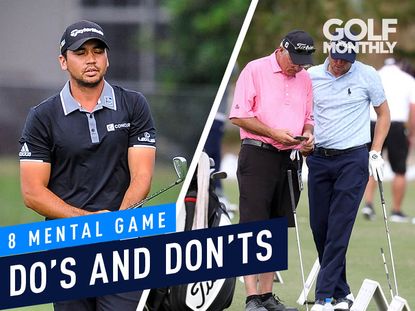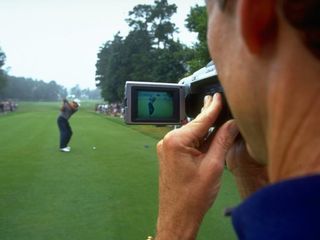8 Mental Game Do's And Don'ts
PGA Professional Alex Elliott gives his eight mental game do's and don'ts


PGA Professional Alex Elliott gives his eight mental game do's and don'ts
8 Mental Game Do's And Don'ts
A lot of us may not have the ability to practice and hone our golf games physically at the moment, but that doesn't mean we can't work on our game at all.
Now is a great time to work on our mental game which is why PGA Professional Alex Elliott in the video below has given his 8 mental game do's and don'ts.
WATCH: 8 Mental Game Do's And Don'ts
8 Mental Game Do's And Don'ts
1. Don't rewatch your golf swing
We are all guilty of this especially in terms of rewatching our golf swings and then critiquing them. All that is going to do is create bad underlying thoughts and make you think you should be changing your swing.
Get the Golf Monthly Newsletter
Subscribe to the Golf Monthly newsletter to stay up to date with all the latest tour news, equipment news, reviews, head-to-heads and buyer’s guides from our team of experienced experts.
The thing we should all be doing is learn to love our golf swing.

2. Don't concentrate on what could have been
Most golfers are guilty of this too when we think back to previous rounds played. Instead the thing to do is look forwards, plan ahead for the next round, work out what is good in our golf games, and work out how we can build with what we've got.
3. Don't compare your circumstances to others
With the growth in social media it is easy to look at what other people are doing and how they are able to work on their golf games physically. However some of us do not have that capability to do so.
The thing to remember here is that you are not going to be at a disadvantage because whilst they may be working on their physical games, you can work on your mental game with some of the tips in this piece.
We all know how much of a difference the mental side of the game makes and yet we often spend little time on it. Perhaps one of the best things we can take from being at home a lot is being able to work on a mental games a bit more.
4. Don't concentrate on your weaknesses
As golfers we like to talk about one part of our game not being as good as other parts and now that we cannot work on them, this can only be accentuated.
The negative thoughts can only do harm here so we have to find a way to reprogram the brain. We don't want to think about weaknesses, instead lets think about how we can build on those weaknesses and strengths with some of the do's below.
1. Do create a shot diary
Go back through your last five rounds and pick out three good shots.
Write down the date you hit the shot and fully describe the shot fully to fill you with good thoughts and give a more positive outlook on your golf game, rather than a negative one.
Alex recommends continuing to do this when golf returns to normal too because eventually you will create such a positive visual image in your mind that you will be able to pull off the shot needed.
2. Visualise the shots in your diary
Again it might sound crazy but the ability to visualise a good shot is a powerful tool that you can call on every time you are faced with a shot.
Where a lot of golfers go wrong is they focus on bad thoughts whereas the power of visualisation can help to re-tune the brain and the mind to think in a more positive way.
3. Watch tour golf
At the moment a lot of TV channels and YouTube channels are putting up old tournaments and moments by some of the best golf players ever.
But don't just watch them for entertainment. Now is a great time to watch tour golf in an educational way. Watch players like Tiger Woods for their demeanour and body language on the course. Watch players like Nick Faldo for their pre-shot routine. Watch players like Ben Hogan for their tenacity.
Watch the top players and look at how they prepare for each shot and how they don't let one shot effect the next.

4. Write down four goals
The four goals Alex wants you to note down for your next game are:
- how many fairways are you going to hit
- how many greens are you going to hit
- how many up and downs are we going to make (in a percentage)
- how many feet of putts are we going to make
If you have clear, achievable targets in those areas the scores will come. The handicap will start coming down as a result.
For more tips do not forget to follow Golf Monthly on Facebook, Twitter and Instagram.

A golfer for most of his life, Sam is Golf Monthly's E-commerce Editor.
Working with golf gear and equipment over the last six years, Sam has quickly built outstanding knowledge and expertise on golf products ranging from drivers, to balls, to shoes.
He combines this knowledge with a passion for helping golfers get the best gear for them, and as such Sam manages a team of writers that look to deliver the most accurate and informative reviews and buying advice. This takes the form of buying guides, reviews, supporting gear content as well as creating deal content.
This is so the reader can find exactly what they are looking for, at a good price.
Sam now spends most of his time testing and looking after golf gear content for the website, whilst he is also responsible for all content related to golf apparel.
Additionally Sam oversees Golf Monthly voucher/coupon content which seeks to find you the best offers and promotions from well-known brands like Callaway, TaylorMade and many more.
Unfortunately, Sam is not a member of any club at the moment but regularly gets out on the golf course to keep up the facade of having a single-figure handicap.
Sam's What's In The Bag:
Driver: Cobra LTDxLS (9 degrees)
Fairway Wood: Ping G430 Max (15 degrees), Nike Covert Tour 2.0 (19 degrees)
Irons (4-PW): Titleist AP2
Wedges: Titleist Vokey SM7 54˚, 58˚
Putter: Scotty Cameron Phantom X 5.5
Ball: Srixon Z-Star Diamond
Shoes: G/FORE Gallivanter/Nike Air Zoom Victory Tour 3/Cuater The Ringer
(For off the course he goes for Nike Jordan 1 Low G shoes as well)
-
 ‘A Real Honour’ – Sky Sports Presenter Joins England Golf As Independent Director
‘A Real Honour’ – Sky Sports Presenter Joins England Golf As Independent DirectorSky Sports Golf presenter Sarah Stirk hopes to use her knowledge and experience to make the sport more open and accessible
By Andrew Wright Published
-
 This Augusta-Inspired Rangefinder Might Be The Coolest Laser We Have Ever Seen
This Augusta-Inspired Rangefinder Might Be The Coolest Laser We Have Ever SeenNeed a rangefinder and love The Masters? Well we have found the perfect laser for you
By Sam Tremlett Published